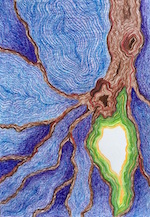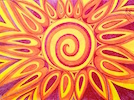“Meditation is the only intentional, systematic human activity which at bottom is about not trying to improve yourself or get anywhere else, but simply to realize where you already are.”
– Jon Kabat-Zinn, Wherever You Go, There You Are
Guided Affective Imagery (GAI, Symbolic Drama)
 An internationally respected, professional and verified technique based on psychoanalytic and psychodynamic theories, GAI enables you to work out conflicts, open up inner resources and support creative processes in detail. The technique uses imaginations, that are worked out and integrated in a subsequent interview. The inner reality is displayed on a symbolic level, including current tuning, conscious and unconscious conflicts. GAI is a psychotherapeutic approach in the treatment of neurotic, functional and psychosomatic troubles. GAI is a short-term psychotherapy, that usually requires less than 20-30 sessions. It can be also used in crisis interventions, traumas and personality disorders. You can read more about GAI here (PDF format).
An internationally respected, professional and verified technique based on psychoanalytic and psychodynamic theories, GAI enables you to work out conflicts, open up inner resources and support creative processes in detail. The technique uses imaginations, that are worked out and integrated in a subsequent interview. The inner reality is displayed on a symbolic level, including current tuning, conscious and unconscious conflicts. GAI is a psychotherapeutic approach in the treatment of neurotic, functional and psychosomatic troubles. GAI is a short-term psychotherapy, that usually requires less than 20-30 sessions. It can be also used in crisis interventions, traumas and personality disorders. You can read more about GAI here (PDF format).
 Mindfulness in Everyday Life
Mindfulness in Everyday Life
Mindfulness Based Stress Reduction (MBSR) is a programme designed by Jon Kabat-Zinn at the University of Massachusetts Medical Center. MBSR uses a combination of mindfulness meditation, body awareness and yoga. According to Kabat-Zinn, the basis of MBSR is mindfulness, which is defined as “moment-to-moment, non-judgmental awareness”. It can help people with anxiety, depression, chronic pain and other disturbances caused by stress. Learning to be aware of our sensations, feelings in our inner body, emotions and thoughts, practising to be mindful during the day while going through simple activities such as eating, walking, taking a shower, waiting in a queue, driving, cleaning, and having a conversation allows us to fully experience life. Concentrated attention to present moment decreases useless disturbing and often repetitive thoughts and therefore reduces fear, anxiety, worries and allows us to perceive the reality and see our options clearly. One of the techniques trying to “tame” the mind is meditation.
“Most people assume that meditation is all about stopping thoughts, getting rid of emotions, somehow controlling the mind. But actually it’s … about stepping back, seeing the thought clearly, witnessing it coming and going.” — Andy Puddicombe
I have been myself practising two main Buddhist meditations – Loving Kindness meditation Metta Bhavana and Mindfulness of Breathing Meditation. Long term cultivation of awareness brings inner peace and joy.
Healing the Inner Child
- inspired by John Bradshaw´s book Homecoming.
 During our sessions we talk about your personal history and childhood memories, we make contact with your inner child, listen to him/her, care for him/her, embrace him/her and heal his/her early traumas. The child´s pain stop influencing your current life and you will be able to make peace with your past and yourself.
During our sessions we talk about your personal history and childhood memories, we make contact with your inner child, listen to him/her, care for him/her, embrace him/her and heal his/her early traumas. The child´s pain stop influencing your current life and you will be able to make peace with your past and yourself.
Dreamwork
Every dream m ay have several meanings and can be understood on objective or subjective level. The dream usually compensates the conscious attitude on the situation of the dreamer, giving the unconscious view of the situation in order to set a psychic balance. I help the dreamer to recall and continue (when needed) his/her dream in induced relaxed state of mind, work with his/her dream images, feelings and associations and guide the dreamer to understand the hidden message of the dream.
ay have several meanings and can be understood on objective or subjective level. The dream usually compensates the conscious attitude on the situation of the dreamer, giving the unconscious view of the situation in order to set a psychic balance. I help the dreamer to recall and continue (when needed) his/her dream in induced relaxed state of mind, work with his/her dream images, feelings and associations and guide the dreamer to understand the hidden message of the dream.
Relaxation techniques
Autogenic Training (AT)
Autogenic Training is a relaxation technique developed by German psychiatrist J.H. Schultz in 1932. AT is a technique based on autohypnosis. The technique influences the autonomic nervous syste m, restoring the balance between the activity of the sympathetic (flight or fight) and the parasympathetic (rest or digest) branches. It brings important health benefits as the parasympathetic activity promotes digestion and bowel movements, lowers the blood pressure, slows the heart rate, and promotes the functions of the immune system. It helps to alleviate many stress induced psychosomatic disorders and loosens and dissolves negative emotions, such as anxiety and fear.
m, restoring the balance between the activity of the sympathetic (flight or fight) and the parasympathetic (rest or digest) branches. It brings important health benefits as the parasympathetic activity promotes digestion and bowel movements, lowers the blood pressure, slows the heart rate, and promotes the functions of the immune system. It helps to alleviate many stress induced psychosomatic disorders and loosens and dissolves negative emotions, such as anxiety and fear.
Practice is recommended every day, by lying down or sitting like a rag doll. The training is contraindicated for people with heart conditions and psychotic disorders. It includes several phases: Heaviness of the body, Warmth of the body, A calm and steady heart, Calm Breathing, Soft and warm stomach, Cool forehead.
Condensed Autogenic formula: My arms and legs are heavy and warm. My heartbeat and breathing are calm and steady. My stomach is soft and warm. My forehead is cool. I feel very calm. AT is contraindicated for people with heart conditions and psychotic disorder.
Body Scan
Body Scan is a meditative technique that teaches you to be aware of the feelings in your body. Moving from head to toe, you pay attention to the specific areas of the body and in some of the m you might notice feelings of tightness or pain. As you focus on any uncomfortable sensations you find and breathe into them, the sensations might at first intensify but after a while, they reduce or disappear completely. The body feels relaxed and released. Body Scan enables you to have a better access to your body feelings and emotions. It is also a great tool for practicing concentration.
m you might notice feelings of tightness or pain. As you focus on any uncomfortable sensations you find and breathe into them, the sensations might at first intensify but after a while, they reduce or disappear completely. The body feels relaxed and released. Body Scan enables you to have a better access to your body feelings and emotions. It is also a great tool for practicing concentration.
Hypnosis
Hypnosis is an altered state of consciousness induced with the help of therapist. Under hypnosis your attention is focused and you usually feel calm and relaxed. You are open to suggestions, but never lose control of your behavior. Hypnosis is an effective therapeutic technique that can reduce anxiety and pain, help you sleep better, alleviate symptoms of psychosomatic disorders (as high blood pressure, disturbed digesting, skin issues..) and increase your physical well-being (giving up smoking, losing weight..)
“Who looks outside, dreams; who looks inside, awakes.” – Carl Gustav Jung
